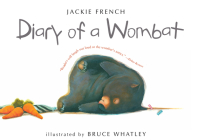It was so lovely to have you visit. I've put up a picture in the sidebar of you reading Dodsworth in London to Eleanor -- the seriousness of her face, and the smile on yours, make me very happy.
And you came bearing gifts!
In the two days since you were here, we've become very interested in wombats: furry, battering-ram headed bearlike Australian creatures. This newfound interest is, of course, on account of the two wombat books you left us with, both by Jackie French, with wildly appealing illustrations by Bruce Whatley.
They are an interesting pair of books: a picture book, and a short non-fiction chapter book about the history and habits of wombats, clearly aimed at older readers.
First, the picture book:
Diary of a Wombat is exactly that:
Monday
Morning: Slept.
Evening: Ate grass.
Scratched.
Night: Ate grass.
Tuesday
Morning: Slept.
Afternoon: Slept.
Evening: Ate grass.
Night: Ate grass. Decided grass is boring.
Scratched. Hard to reach the itchy bits.
On Wednesday, new neighbors (a family of people) move in, and the wombat begins to interact with them, fighting a major battle with their doormat ("flat, hairy creature invading my territory"), demanding carrots, digging holes in the garden, banging on a metal garbage can to demand still more carrots. From the combination of French's deadpan text and Whatley's sleepy-eyed wombat illustrations, you get the sense that wombats are strong, stubborn, and single-minded, as well as being extremely cute when rolling around on their backs. The wombat trains her neighbor humans (oh yes, on the gender-of-animals front, it's made clear on one page that the wombat is female) to take care of her when needed, and seems quite happy with her situation. It's enormously appealing.
 How to Scratch a Wombat is a longer and far more in-depth read. In it, French provides some of her personal history with wombats -- she's lived with them invading her garden, and sometimes her house, for more than 30 years. French's stories of individual wombats (all named, all described like old friends) are funny and full of personality. She interweaves her anecdotes with straightforward wombat facts: what they eat (mostly grass), how their anatomy functions (they are marsupials, with pouches, and have extremely strong skulls, "bums," and clawed digging paws), their place in Australian history (hunted down as pest by white settlers), and more. Whatley combines his cartoon-like illustrations here with far more realistic ones in shaded pencil, so that you get a good sense of how wombats really look and act.
How to Scratch a Wombat is a longer and far more in-depth read. In it, French provides some of her personal history with wombats -- she's lived with them invading her garden, and sometimes her house, for more than 30 years. French's stories of individual wombats (all named, all described like old friends) are funny and full of personality. She interweaves her anecdotes with straightforward wombat facts: what they eat (mostly grass), how their anatomy functions (they are marsupials, with pouches, and have extremely strong skulls, "bums," and clawed digging paws), their place in Australian history (hunted down as pest by white settlers), and more. Whatley combines his cartoon-like illustrations here with far more realistic ones in shaded pencil, so that you get a good sense of how wombats really look and act.Eleanor has not historically been drawn to non-fiction books, but she's sustained an interest in this one, and we're both enjoying the combination of fact and personal narrative. I appreciate particularly the way French stresses the dangers of co-habiting with wild animals: yes, wombats can be adorable, but she describes in detail the time a wombat tore a gash in her wrist when he thought they were playing a game. Despite the anthropomorphizing in Diary of a Wombat, French keeps the wildness of the wombats front and center.
I look forward to hearing more about the BEA conference -- I hope this morning's panel was excellent!
Love, Annie


I fell for Diary of a Wombat while I was in Australia and brought a copy home for my niece! I look forward to reading it with her in two or three years. (She's just barely born now, it's gonna require a lot of patience.)
ReplyDelete